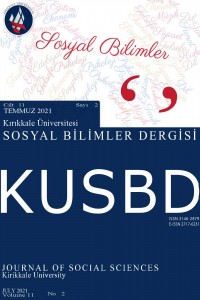Abstract
Döviz kuru; bir ülkenin para biriminin başka bir para birimi cinsinden fiyatı olarak tanımlanmaktadır. Döviz kuru dalgalanması veya istikrarı ise ekonomik büyümenin kuantumunu ve yönünü belirleyen temel sorundur. Döviz kuru dalgalanması, döviz kurundaki öngörülemeyen hareketlerle ilişkili risk olarak tanımlanmaktadır. Dolayısıyla bu konu, hem gelişmiş ekonomiler hem de Türkiye gibi gelişmekte olan ekonomiler için oldukça önemli bir konu olarak karşımıza çıkmaktadır. Çalışmanın amacı, Türkiye’de döviz kurlarının ekonomik büyüme üzerindeki etkilerini ortaya koymaktır. Bu hususta 2003Ç1 ile 2019Ç4 yılları arasında çeyreklik veriler kullanılarak Vectör Otoregresif yöntemi yardımıyla analiz gerçekleştirilmiş ve bulgularda; Türkiye’de döviz kurundaki azalmaların veya azaltıcı politikaların, ekonomik büyümeyi pozitif yönde etkilediği tespit edilmiştir. Bu sonucun bağlayıcıları, politika yapıcıları tarafından uygulanan ekonomi politikalarıdır. Diğer bir ifadeyle bulguların, teorik çerçeveyle uyumlu olmadığı görülmüştür.
Keywords
References
- Abdoh, W. M. Y. M., Yusuf, N. H. M., Zulkifli, S. A. M., & Ibrahim, N. J. (2016). Macroeconomic factors that ınfluence exchange rate fluctuation in ASEAN countries. International Academic Research Journal of Social Science, 2(1), 89-94.
- Cameron R., and Neal L. (2004). Historia gospodarcza swiata. Warszawa: książka i wiedza.
- Çelik, T., Çelik, B. & Barak, D. (2016). Geçiş ekonomilerinde reel döviz kuru ve ekonomik büyüme ilişkisi. Süleyman Demirel Üniversitesi İktisadi ve İdari Bilimler Fakültesi Dergisi, 22 (3), 877-890.
- Danmola, R. A. (2013). the impact of exchange rate volatility on the macro economic variables in Nigeria. European Scientific Journal, 9 (7), 152-165.
- Demir, E. & Yenipazarlı, A. (2020). Döviz kurlarının enflasyon üzerindeki etkisi: Türkiye üzerine ampirik bir inceleme. Alanya Akademik Bakış Dergisi, 4(2), 193- 204.
- Demir, E. (2018). Dış borçların enflasyon üzerine etkisi: Türkiye örneği (1990-2017). (Yayınlanmamış Yüksek Lisans Tezi), Adnan Menderes Üniversitesi Sosyal Bilimler Enstitüsü, Aydın.
- TCMB (2020). Elektronik veri dağıtım sistemi, https://evds2.tcmb.gov.tr/ (18.05.2020).
- Genberg, H. & Swoboda, A. K. (2004). Exchange rate regime: Does what countries say matter?. HEI Working Paper, No. 7. Haller, A. P. (2012). Concepts of economic growth and development. Challenges of crisis and of knowledge. Economy Transdisciplinarity Cognition. 15 (1/2012), 66-71
- He, Q. (2010). Expanding varieties ın the nontraded goods sector and the real exchange rate depreciation. Journal Of International nad Global Economic Studies, 3(2), 19-38.
- Khan, M. K., Teng, J. Z., & Khan, M. I. (2019). Cointegration between macroeconomic factors and the exchange rate usd/cny. Financial Innovation, 5(2019)
- Khondker, B. H., Bidisha, S. H., & Razzaque, M. A. (2012). The exchange rate and economic growth: An empirical assessment on Bangladesh. Working Paper, Country project on Bangladesh, International Growth Centre, Bangladesh.
- McPherson, M.F., & Rakovski, T. (2000, Temmuz). Exchange rates and economic growth in Kenya: an econometric analysis. African Economic policy Discussion Paper. Washington, 1-14.
- Osundina, K. C., & Osundina, J. A. (2014). capital accumulation, savings and economic growth of a Nation – Evidence from Nigeria. Global Journal of Interdisciplinary Social Sciences, 3 (3), 151- 155.
- Peru, F. (1986). Za Filozofiju Novog Razvoja. Serbia: Evropski centar za mir i razvoj
- Rahman, M., & Ghosh, S. K. (2013). Influence of demand–supply forces on exchange rate movement. Bank Parikrama, 38 (3-4), September & December, 107 – 128.
- Ramasamy, R., & Abar, S. K. (2015). Influence of macroeconomic variables on exchange rates. Journal of Economics, Business and Management, 3 (2), 276- 281.
- Rodrik, D. (2008). The Exchange Rate and economic growth. Brookings Papers on Economic Activity, 2, 365-412.
- Sibanda, K., Ncwadi, R. & Mlambo, C. (2012). Investigating the impacts of real exchange rates on economic growth: A case study of South Africa. Mediterranean Journal of Social Sciences, 4 (13), 261-274.
- Tarawalie, A. B. (2010). Real exchange rate behaviour and economic growth: evidence from Sierra Leone. South African Journal Of Economic Management Sciences, 13 (1), 8-23
- Ünlü, H. (2016). Döviz kuru oynaklığı ve ekonomik büyüme: Türkiye Örneği. Sakarya İktisat Dergisi, 5 (3), 17-31.
- Vieira, F. V., Holland, M., Silva, G. D., & Bottecchia, L. C. (2013). Growth and exchange rate volatility: A panel data analysis. Applied Economics, 45 (26), 3733-3741.
- Wong, H. T. (2013). Real exchange rate misalignment and economic growth in Malaysia. Journal of Economic Studies, 40(3) 298–313.
Details
| Primary Language | Turkish |
|---|---|
| Journal Section | Makaleler |
| Authors | |
| Publication Date | July 31, 2021 |
| Submission Date | December 19, 2020 |
| Published in Issue | Year 2021 Volume: 11 Issue: 2 |

